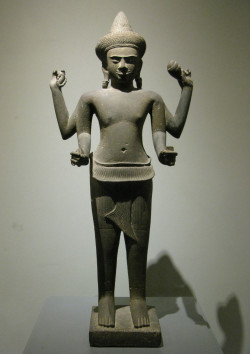ค้นหางานศิลปกรรม
ฐานข้อมูลศิลปกรรมในเอเชียตะวันออกเฉียงใต้
พระโพธิสัตว์อวโลกิเตศวร
คำสำคัญ :
| ชื่อหลัก | พิพิธภัณฑสถานแห่งชาติ พระนคร |
|---|---|
| ประเภทงานศิลปะ | ประติมากรรม |
| ตำบล | พระบรมมหาราชวัง |
| อำเภอ | เขตพระนคร |
| จังหวัด | กรุงเทพมหานคร |
| ภาค | ภาคกลาง |
| ประเทศ | ไทย |
| พิกัดภูมิศาสตร์ ค่าองศาทศนิยม | Lat : 13.7576 Long : 100.492222 |
| พิกัดภูมิศาสตร์ พิกัดกริด | Zone : 47 P Hemisphere : N E : 661329.97 N : 1521418.09 |
| ตำแหน่งงานศิลปะ | จัดแสดงภายในพิพิธภัณฑสถานแห่งชาติ พระนคร |
| ประวัติการสร้าง | ไม่ปรากฏหลักฐานลายลักษณ์อักษรที่กล่าวถึงประวัติการสร้าง แต่จากรูปแบบทางศิลปกรรมที่เทียบได้กับประติมากรรมในศิลปะเขมรแบบนครวัด จึงกำหนดอายุว่าสร้างขึ้นในระยะเวลานี้ ราวพุทธศตวรรษที่ 17 |
|---|---|
| กระบวนการสร้าง/ผลิต | หินทรายแกะสลัก |
| ลักษณะทางศิลปกรรม | พระโพธิสัตว์อวโลกิเตศวรยืนตรงบนฐานหน้ากระดาน พระพักตร์เหลี่ยม พระขนงคมเป็นสัน พระเนตรเบิกโพรง พระนาสิกและพระโอษฐ์สมส่วน สวมกุณฑลทรงตุ้มแหลม สวมกระบังหน้าและรัดเกล้ากรวยเทียบได้กับเทวรูปในศิลปะนครวัด กึ่งกลางของรัดเกล้ามีร่องรอยพระพุทธรูปซึ่งถูกกะเทาะรายละเอียดออก พระพุทธรูปที่รัดเกล้าทำให้เชื่อว่าประติมากรรมนี้เป็นรูปพระโพธิสัตว์อวโลกติศวร เพราะเป็นหนึ่งในสัญลักษณ์ประจำพระองค์ โดยพระพุทธรูปนี้คือพระธยานิพุทธเจ้าอมิตาภะ ผู้บันดาลให้พระโพธิสัตว์อวโลกิเตศวรถือกำเนิดขึ้นมา พระวรกายด้านบนเปล่าเปลือย พระวรกายด้านล่างสวมพตสั้น สลักลายเส้นตรงทำให้เหมือนเป็นผ้าอัดกีบ ชักชายผ้าเป็นวงโค้งบริเวณใต้พระอุทร และมีชายผ้าทรงคล้ายหางปลาพาดลงตรงกลาง ลักษณะผ้านุ่งดังกล่าวนี้เป็นรูปแบบของประติมากรรมในศิลปะแบบนครวัด พระกรทั้งสี่ถือสิ่งของต่างๆ ที่เป็นของประจำพระองค์ กล่าวคือ พระหัตถ์ขวาล่างถือดอกบัว พระหัตถ์ขวาบนถือประคำ พระหัตถ์ซ้ายล่างถือคัมภีร์ พระหัตถ์ซ้ายบนถือสังข์ |
| ข้อมูลที่สำคัญทางวิชาการ | ประติมากรรมนี้นับว่าเป็นรูปปพระโพธิสัตว์อวโลกิเตศวรในศิลปะเขมรในประเทศไทยที่สมบูรณ์ที่สุด สร้างขึ้นราวพุทธศตวรรษที่ 17 ศิลปะแบบนครวัด นับว่าน่าสนใจยิ่งเพราะในระยะนั้นพุทธศาสนามหายานไม่แพร่หลายในดินแดนไทยมากนักเมื่อเทียบกับศาสนาพราหมณ์ เมื่อผนวกรวมกับหลักฐานพระโพธิสัตว์สมัยก่อนเมืองพระนครที่พบจำนวนมากสะท้อนให้ห็นว่า สายวัฒนธรรมเขมรในดินแดนไทยมีการนับถือศาสนาพุทธมหายานมาโดยตลอดไม่ขาดตอน |
| ข้อสังเกตอื่นๆ | การกะเทาะพระพุทธเจ้าอมิตาภะที่รัดเกล้าออกจนเหลือแต่โครงอาจเกิดขึ้นภายหลังรัชกาลของพระเจ้าชัยวรมันที่ 7 ขณะนั้นศาสนาพราหมณ์ได้กลับมามีบทบาทอีกครั้งหนึ่ง ทำให้เกิดการทำลายพระพุทธรูปจำนวนมาก |
| สมัย/รูปแบบศิลปะ | ลพบุรี, เขมรในประเทศไทย, นครวัด |
| อายุ | พุทธศตวรรษที่ 17 |
| ศาสนา | พุทธ |
| ลัทธิ/นิกาย | มหายาน |
| ศาสนา/ความเชื่อที่เกี่ยวข้อง | ตามคติพุทธศาสนามหายานเชื่อกันว่าพระโพธิสัตว์อวโลกิเตศวรมีความกรุณายิ่ง ถือกำเนิดจากพระธยานิพุทธเจ้าอมิตาภะ ในวาระระหว่างที่พระศากยมุนีพุทธเจ้าเสด็จดับขันธ์ปรินิพพานไปแล้วและพระศรีอาริย์พุทธเจ้ายังไม่ลงมาตรัสรู้ พระองค์จะคอยช่วยเหลือปวงสัตว์โลกให้ข้ามห้วงสังสารวัฏ รูปแบบของกระบังหน้า รัดเกล้า กุณฑล และผ้านุ่ง เทียบได้กับเทวรูปในศาสนาพราหมณ์ อาศัยจากสิ่งของในมือและพระอมิตาภะที่มวผยมจึงทราบว่าเป็นพระโพธิสัตว์อวโลกิเตศวร สะท้อนให้เห็นว่าศิลปกรรมเนื่องในศาสนาทั้งสองมีการใช้ร่วมกัน หรืออีกนัยหนึ่งกล่าวได้ว่ารูปแบบของประติมากรรมในศาสนาพราหมณ์มีบทบาทต่อประติมากรรมในพุทธศาสนา |
| รูปแบบลิขสิทธิ์ | Attribution-NonCommercial-NoDerivs (CC BY-NC-ND) |
|---|---|
| เจ้าของสิทธิ์ | ศูนย์มานุษยวิทยาสิรินธร (องค์การมหาชน) |
| วันที่จัดทำข้อมูล | 2016-09-30 |
| ผู้จัดทำข้อมูล | รุ่งโรจน์ ธรรมรุ่งเรือง |
| บรรณานุกรม | สุภัทรดิศ ดิศกุล, หม่อมเจ้า. ประติมากรรมขอม. กรุงเทพฯ : กรุงสยามการพิมพ์, 2515. สุภัทรดิศ ดิศกุล. ศิลปะขอม. กรุงเทพฯ : องค์การค้าของคุรุสภา, 2533. สุภัทรดิศ ดิศกุล, หม่อมเจ้า. ศิลปะสมัยลพบุรี. กรุงเทพฯ : มหาวิทาลัยศิลปากร, 2547. |


